New All-Time Highs For The Leading Stock Indices – But “Rotation” Rules
The S&P and the DJIA came roaring back and hit new All-Time highs after that tiny 6% dip in September (capital flows show that retail and hedge funds Bought-The-Dip), but the tech-heavy NASDAQ and the small-cap Russell fell short of making new highs. The Transports and the TSE smoked the other indices.
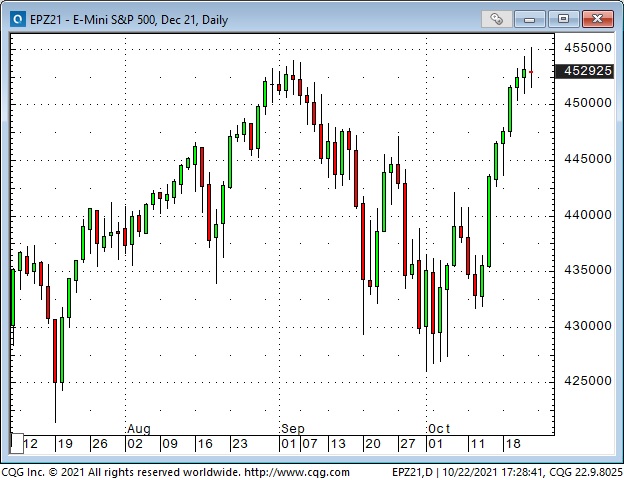



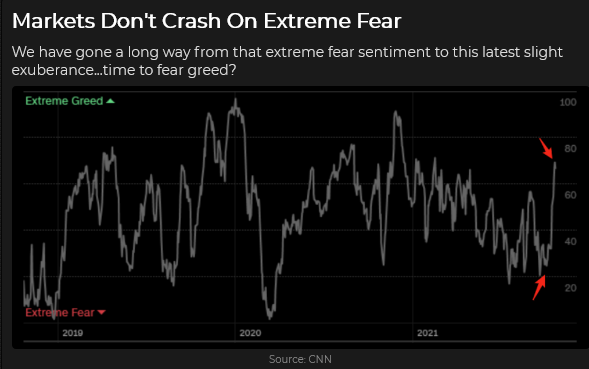
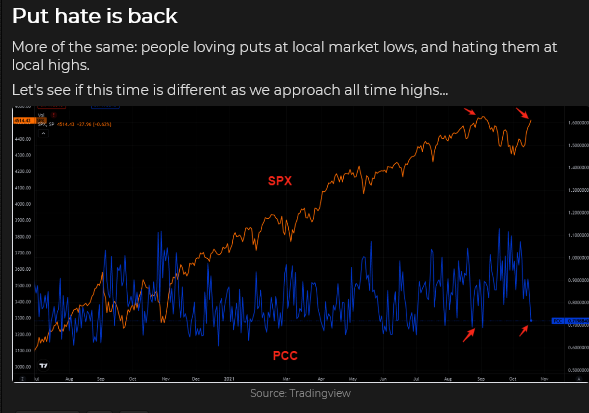
Energy markets continued to rip higher—Crude oil, Gasoline, Heating oil and Uranium were at 7-year highs.
WTI has risen for nine consecutive weeks.
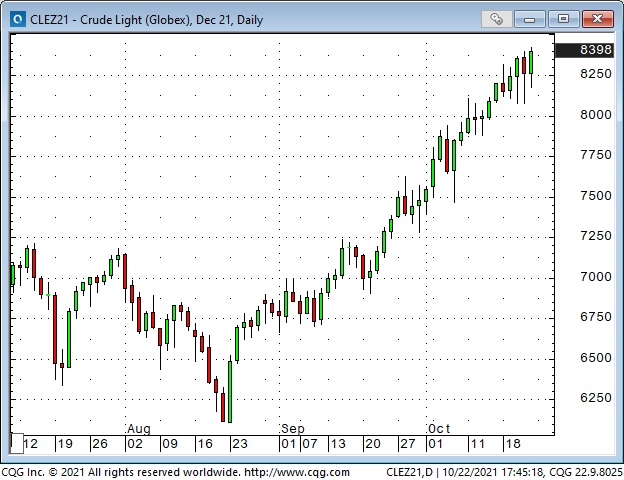

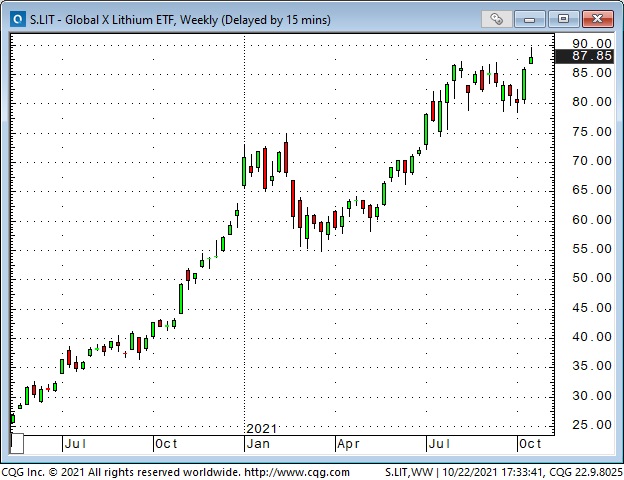
Something Big Was Happening In The WTI Forward Curve
The premium of front-month WTI soared over the deferred months while the entire backward dated curve steepened. Is this caused by shortages of physical WTI for near-immediate delivery? Is it due to speculators concentrating their buying in front-month contracts? Is it a sign that margin clerks were lifting every offer they could find to liquidate a colossal spec short position? Is it just another example of the Brave New World of energy markets—and players beware?
One odd thing—while WTI prices have soared and time spreads have exploded, the implied vol on WTI options has done nothing. It sits around the mid-range, where it has been for the past several months.
This spread chart shows that December WTI traded at a premium of ~$1.50 over March in early October. By Friday, the premium had soared to ~$4.25.
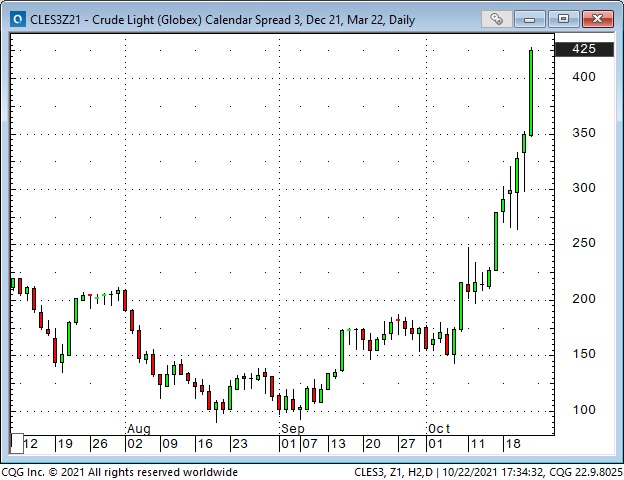
Copper spreads soared on physical shortages.

Interest rates were rising as markets prepare for Central Bank tightening. Short rates were rising faster than long rates.
The long bond hit an All-Time low yield (high price in this chart) in August 2020.
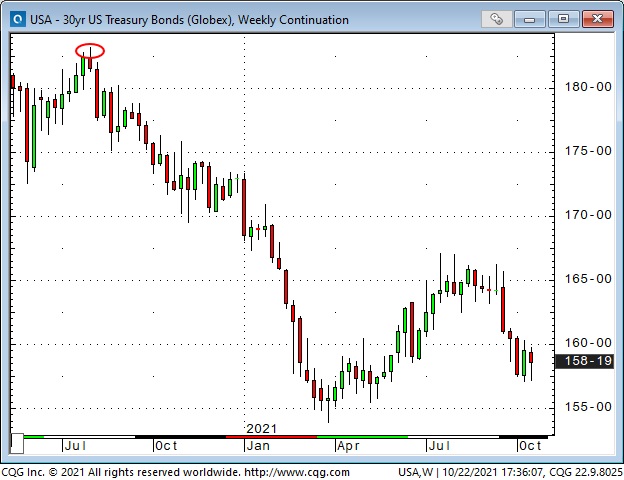
The monthly Bank of America survey of Fund Managers showed them to be the “shortest” of bonds in the survey’s 20-year history.
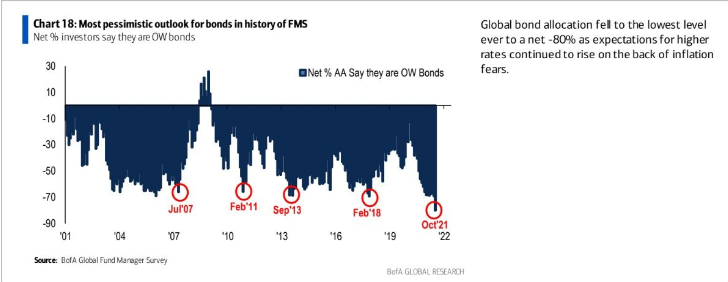
Short rates were rising faster than long rates.
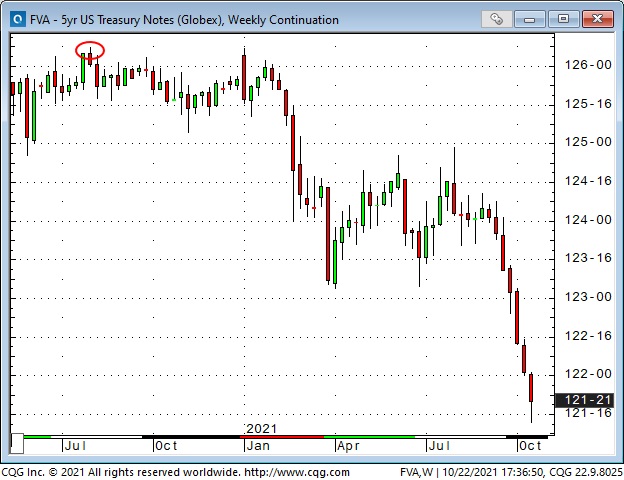

The US dollar fell from one-year highs as “risk-on” sentiment flooded the markets.

The yen has been the weakest of the major currencies Vs. the USD, down ~10% YTD. The Korean won was also down ~10% YTD.
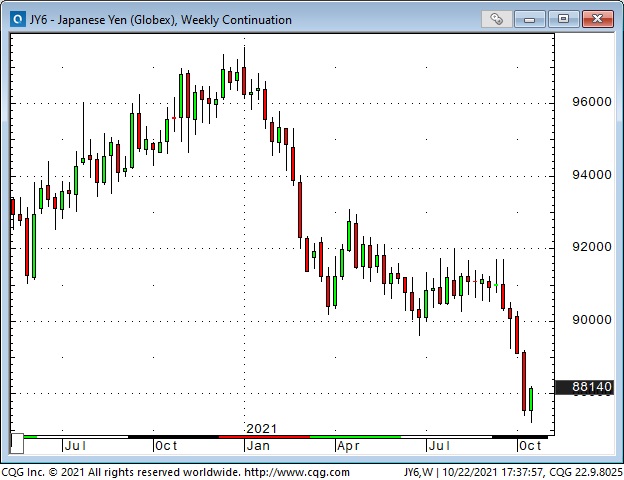
The CAD and the Russian Ruble (commodity currencies) were two of the few actively traded currencies that have risen YTD vs the USD. The CAD was at a 6-year high vs the yen. Was it as simple as Japan is a vast energy importer while Canada is a net energy exporter?

From the viewpoint of a cynical (or realistic) FX speculator, the price of CAD/USD is a function of 1) the relative strength of the USD Vs. other currencies, 2) the relative strength of the commodity markets, especially fossil fuels, and, 3) the relative strength of the stock market. Think of the CAD as a cork floating in the ocean—where the “water” is the USD, the commodity market and the stock market. Canadian domestic inputs have relatively little impact on the CAD/USD. CAD short rates are now premium to USD short rates, but that is not nearly as important as the Big Three factors.
Gold hit a 6-week high above $1,800 on Friday, but…

Gold was up >$30 early during the NY “floor” session on Friday, Oct. 22, but tumbled >$30 in just over 30 minutes mid-day when Powell confirmed that the Fed would go ahead with their “taper” plans.
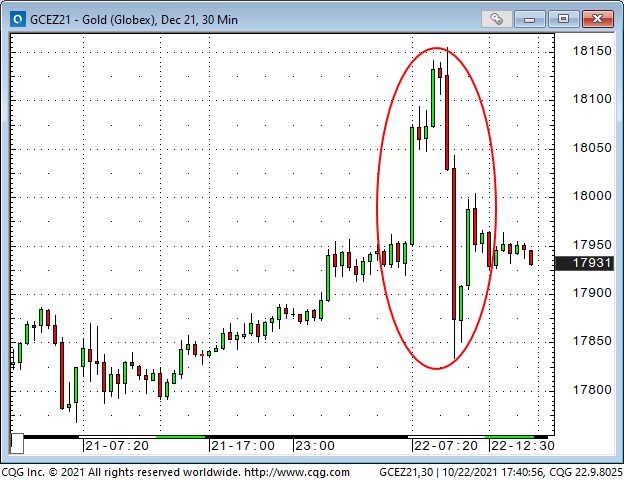
Gold and the USD have had a strong negative correlation YTD. In this chart, gold (pink line) is inverted. The blue line is the US Dollar index.

My Short Term Trading
I started the week flat and did nothing for the first three days. Call it a mini-vacation or say I was patiently waiting for a setup I liked.
Over the past few weeks, I have been both long and short stock indices. I had closed out a long position late last week for a decent profit, and I was looking for the market to roll over this past week. I did not short the market Monday through Wednesday because it was trending higher. I thought I saw a topping pattern on Thursday (selective vision), and I got short. I was quickly stopped out for a small loss. The same thing happened on Friday. I’m flat at the end of the week, and my P+L was down ~0.4% on the week.
On My Radar
I’m well aware that the seasonal trend of the stock market is higher for the rest of the year—and that the stock market seems very capable of absorbing “bad” news and continuing to rally. I’m not a perma-bear (although I like to fade irrational exuberance), and I have made money buying stock indices recently, but, this coming week, I’ll be looking for setup opportunities to short stock indices or other examples of speculative excess!
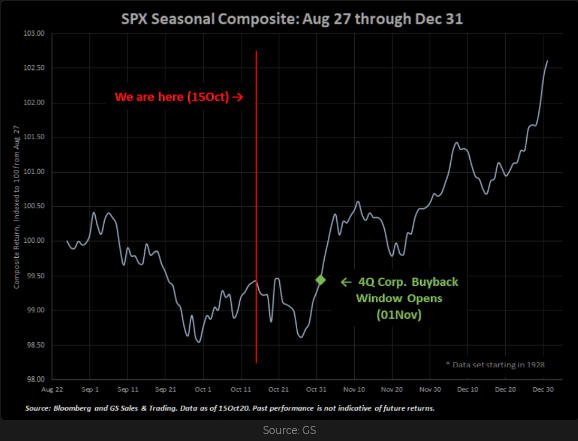
I interviewed Bill Fleckenstein years ago. He gave me some great advice about shorting:
“I don’t short markets because I think they’re overvalued. Markets can easily get much more over-valued. I short markets that I have good reason to believe are going to go down. One of the best reasons they may be going down is that they have already started to go down. You want to shoot them in the back.”
Thoughts On Trading
I rarely write about crypto. I don’t know what it is, but I’m curious about it in terms of market psychology. Is it, for instance, the posterchild for hot money seeking the new, new thing? Is it the perceived hedge against inflation for the millennial generation, as gold was for the boomers? Is it the modern version of tulip mania, or will digital currencies become the backbone of global finance?
Forty years ago, I was in the main trading room of (what became) one of Canada’s largest bank-owned brokerage firms. They traded “everything” on that floor, but the guy I was visiting traded absolutely nothing but the CAD/USD. He wasn’t a market-maker; he was a prop trader, so he only traded when he wanted to. He seemed to be well respected by other traders on the floor, and he “took input” from everybody about what was happening in their markets, but he only traded CAD/USD.
I’m interested in all kinds of markets; I’m a Macrotourist, but I don’t “feel the need” to trade all the markets. I also don’t “feel the need” to trade just one market. One of my core beliefs is that successful traders find a way to participate in markets that suit them.
I sometimes wonder if my Old School metrics for understanding things like value, or rate of change, are out-of-step with markets these days.
Quotes From The Notebook
“In an inflationary world, you want to have a strong currency if you’re an importer.” Louis Gave, in an interview with Grant Williams 2021
My comment: I listened to that podcast a few days ago and immediately thought this quote was an example of cognitive dissonance. A strong currency would be great because it would make imports cheaper, but don’t net importers ultimately get a weaker currency?
“It is easier to spend money than it is to make it. When there is no money coming in the door, LOVE flies out the window.” My Grandmother 40 years ago
My comment: Forty years ago, commodity brokers were making lots of money, driving new sports cars, while stockbrokers were taking the bus to work, carrying their lunch in a paper bag. We used to have expensive lunches and would say, “It’s only three ticks in the bonds,” when we ordered another $100 bottle of wine. Easy come, easy go, but there are always consequences.
“We couldn’t panic even if we wanted to…there were NO bids to hit!” Steve Leuer S&P floor broker during the August 2015 market break
My comment: If you’re going to panic, panic early!
“If you want to make God laugh…tell him you’ve got a plan.” Woody Allen (and other people)
“Everyone has a plan until they get punched in the mouth.” Mike Tyson 1987
My comment: Making plans is a good idea, but since Anything Can Happen, be prepared that your plans don’t work out.
“You have to assume that the money in your client’s account is all the money he has.” Peter Appleby, Branch Manager, ContiCommodity 1984 – in reply to a broker telling Peter that he was confident his client would come up with the money to meet his margin call.
My comment: When I was a branch manager, I always told my guys to never let a client use more than 50% of his capital to margin trades. Clients who constantly used 100% (or more) of their capital for margin purposes ALWAYS went broke—and took somebody down with them— usually their broker!
